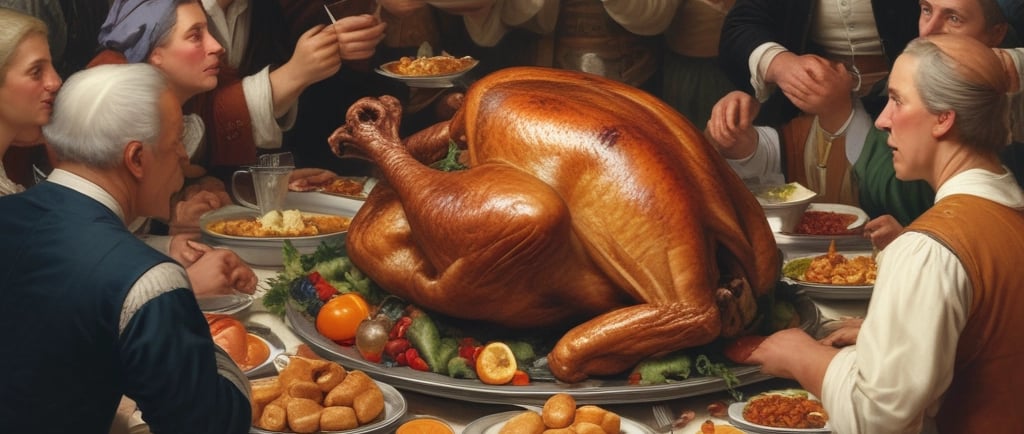The Tradition of Turkey: Why It's the Star of Thanksgiving in America
Thanksgiving history and turkey traditions in America — explore how the 1621 Pilgrim and Wampanoag harvest feast inspired the first Thanksgiving, leading to turkey becoming the holiday’s iconic main dish. Learn why turkey was chosen for its abundance, size, and symbolism of gratitude, how it evolved into the national centerpiece after Lincoln’s 1863 proclamation, and how preparation methods from roasting to brining and deep-frying shaped modern celebrations. Discover the cultural significance of turkey in family gatherings, gratitude, and American heritage — from colonial roots to today’s Thanksgiving traditions.


The Historical Origins of Thanksgiving and Turkey Consumption
The celebration of Thanksgiving in the United States finds its roots in the early 17th century, largely linked to the arrival of English Pilgrims at Plymouth, Massachusetts. The historical narrative often points to the year 1621, when these settlers, in collaboration with the Wampanoag tribe, held a harvest feast to celebrate their bountiful harvest. This event, often referred to as the First Thanksgiving, laid the groundwork for a tradition that would shape American culture for centuries to come.
During this inaugural feast, a variety of wildfowl, including ducks and geese, supplemented the meal. However, turkeys were also likely present, as they were native to the region and readily available. Documented accounts reveal that turkey was a preferred choice for many settlers due to their size and abundance. The relationship between Native Americans and the Pilgrims during this time was one marked by cooperation, which emphasized shared resources and communal meals, helping to establish the significance of turkey as a symbol of gratitude and festivity.
As the years progressed, Thanksgiving gradually evolved into a formal holiday. By the 19th century, the idea of celebrating Thanksgiving gained traction, leading to its official designation as a national holiday in 1863. During this period, turkey became increasingly associated with the Thanksgiving celebration due to its size, making it the ideal centerpiece for family gatherings. The practice of serving turkey on this day was further popularized through various publications and cookbooks, solidifying its status as a holiday staple.
In summary, the historical origins of Thanksgiving underscore the integral role of turkey in American festive traditions. As the United States transitioned from a colony to a nation, these early customs played a critical part in shaping the modern Thanksgiving experience, embedding turkey firmly within the cultural fabric of this beloved holiday.
Why Turkey Became the Traditional Main Dish
The tradition of serving turkey during Thanksgiving has deep roots in American history and culture, making it the quintessential main dish for this annual celebration. One of the primary reasons for selecting turkey as the centerpiece of the Thanksgiving meal is its abundance in the wild. Native to North America, wild turkeys were readily available to early settlers, which significantly contributed to their choice as the main dish. The substantial size of these birds made them particularly suitable for large gatherings, ensuring that families could feed many guests during this communal holiday.
In the early years of American agriculture, domesticated turkey became a staple as it was easier to raise compared to other livestock, such as cows or pigs, which required more resources and space. Turkeys are relatively hardy birds and could thrive on the diverse diets provided by early American gardens. This made them a practical option for families looking to celebrate the harvest while practicing self-sufficiency.
Furthermore, turkey began to symbolize more than just sustenance; it came to represent the spirit of Thanksgiving itself. The harvest season was a time to express gratitude for the year’s bounty, and turkey emerged as a symbol of thankfulness and abundance. As the United States grew and evolved through the centuries, turkey also became an emblem of American identity and unity. The popularity of Thanksgiving grew, and the turkey became firmly entrenched in the yearly celebrations, transcending its role simply as a meal. This evolution further solidified turkey's place on the Thanksgiving table, as it encapsulated not only tradition but also the values of gratitude, community, and national pride that define the spirit of the holiday.
Preparation Methods: From Traditional to Modern
Thanksgiving in America invariably centers around the turkey, an integral symbol of the holiday. The preparation of turkey has undergone significant transformations over the years, with various methods emerging to cater to diverse culinary preferences and advancements in cooking techniques. Traditional methods primarily involve roasting, where the turkey is seasoned and cooked in an oven until the skin is golden brown and the meat reaches a succulent tenderness. This age-old method encapsulates the essence of Thanksgiving, often interwoven with family recipes that have been cherished for generations.
Over time, however, modern techniques have begun to influence how turkey is prepared across households. One popular contemporary method is deep-frying, which involves immersing a whole turkey in hot oil, resulting in a crispy exterior while retaining juicy meat inside. This method has gained traction for its efficiency, as it significantly reduces cooking time compared to traditional roasting. Moreover, deep-fried turkey has a distinct flavor profile, often enhanced by the use of seasonings and marinades.
Another modern technique that has surged in popularity is brining. This process involves soaking the turkey in a solution of water, salt, and various seasonings prior to cooking. Brining serves to infuse the turkey with moisture and flavor, ensuring a luscious end product. Additionally, brining can lead to a more evenly cooked turkey, preventing the white meat from drying out during the roasting process. As families increasingly embrace these modern preparation methods, it is evident that the process of cooking turkey for Thanksgiving is not static but rather a dynamic tradition shaped by regional tastes, cultural influences, and personal preferences.
Cultural Significance and Modern-Day Thanksgiving Traditions
The Thanksgiving holiday in America is not merely a day marked on the calendar; it embodies cultural significance steeped in themes of family togetherness, gratitude, and the celebration of abundance. At the heart of this holiday tradition is the turkey, a centerpiece that symbolizes unity and sharing among family members and friends. The preparation and enjoyment of a turkey dinner invoke a sense of nostalgia, often reminding individuals of cherished memories from past gatherings.
As families come together to partake in a festive meal, the act of gathering around the turkey creates an emotional connection that transcends generations. Many American households show a deep appreciation for the holiday's roots, celebrating with traditional dishes that hold special meaning. However, it is essential to acknowledge that the way Thanksgiving is observed often varies significantly across different families and communities. These variations may reflect cultural backgrounds, regional influences, and even personal experiences, contributing to the rich tapestry of modern Thanksgiving traditions.
For some families, the focus might be on a grand turkey feast with all the accompaniments, while others may opt for a more simplified or even an unconventional meal, showcasing a diversity of culinary practices. In this regard, turkey serves not only as a meal but also as a symbol of the connections that bind individuals to one another, fostering an atmosphere of gratitude and joy. The holiday encourages people to reflect on their blessings and express their appreciation, further emphasizing the emotional significance turkey holds during this time.
In light of these varied practices, one can appreciate how this annual celebration remains a vital aspect of American cultural identity, with turkey being a central figure in the collective narrative. Ultimately, Thanksgiving represents a occasion where people unite, share stories, and create lasting memories, making turkey an enduring star of this cherished holiday.
